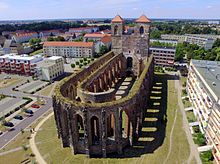St. Nikolai (Zerbst / Anhalt)
The Sankt Nikolai Church (also Sankt Nicolai ) was a Protestant church in Zerbst . The largest church in Anhalt was destroyed in World War II and has been in ruins ever since.
history
As a Romanesque basilica built from granite blocks in the 12th century, it was one of the first sacred stone buildings east of the Elbe and was the focus of the earliest urban development of Zerbst. Only the south tower of this building has survived.
The construction of a new Gothic hall church began around 1430 , also as an expression of the wealth and self-confidence of the citizens in the city's heyday around 1400. The choir was completed in 1446, the nave in 1486. Between 1476 and 1494 the tower room was built. The three stone church spiers that were destroyed in the Second World War were erected in 1533/34. The three-aisled Gothic hall church of St. Nicolai was the town's council church and is an important work of the Parler school.
Starting with St. Nikolai, the Lutheran Reformation was introduced in Zerbst in the early 1520s. The medieval furnishings of the church fell victim to an iconoclasm in 1525 . In 1573 Wolfgang Amling became pastor to St. Nikolai, 1578 superintendent († 1606). As the leading clergyman of the emerging Anhalt State Church - whose first ordinations took place in St. Nikolai in 1578 - he managed its transition to Calvinism . During this time, Gallus Dreßler worked as a deacon (second preacher) and church musician at St. Nikolai. Anhalt-Zerbst returned to the Lutheran creed in 1646.
From 1819 to 1827, at the instigation of Duke Leopold Friedrich von Anhalt-Dessau , the church was comprehensively restored in accordance with contemporary tastes in a historicizing manner.
The church was almost completely destroyed in the bombing raid on April 16, 1945. A complete demolition, which had already been approved, was prevented by private individuals, pastors and preservationists. On June 24, 1991, a support association was founded to protect the ruins. Since then, the north and south towers have been roofed over again, a viewing platform has been set up at the location of the central tower and a new bell has been installed. The restoration of the nave is not planned for the time being.
The ruin is used for concerts and other cultural events.
The north tower contains the largest bell in Anhalt ( Gloriosa ) with a weight of approx. 5 tons.
literature
- Ludwig Puttrich : Short history of the older churches and the monasteries in Zerbst. In the S. (Ed.): Monuments of the architecture of the Middle Ages in the Herzoglich Anhalt'schen Landen. FA Brockhaus, Leipzig 1841 (= monuments of medieval architecture in Saxony , 1st section, vol. 1, part 3), p. 4–15, therein on St. Nikolai p. 4–10 and p. 67 (floor plan and Illustrations of the equipment).
- Wilhelm Schubert: About the construction time of the St. Nikolai Church in Zerbst. Zerbst 1840.
Individual evidence
- ↑ Ludwig Puttrich: Brief history of the older churches and monasteries in Zerbst . In the S. (Ed.): Monuments of the architecture of the Middle Ages in the Herzoglich Anhalt'schen Landen . FA Brockhaus, Leipzig 1841, p. 4.
- ↑ Götz Eckardt (Hrsg.): Fates of German architectural monuments in World War II, a documentation of the damage and total losses in the area of the German Democratic Republic, Volume 1, Berlin 1980, pp. 276-277.
- ↑ Wilhelm Schubert: About the construction time of the Church of St. Nikolai in Zerbst . Zerbst 1840, p. 1.
- ↑ Ludwig Puttrich: Brief history of the older churches and monasteries in Zerbst . In the S. (Ed.): Monuments of the architecture of the Middle Ages in the Herzoglich Anhalt'schen Landen . FA Brockhaus, Leipzig 1841, p. 6.
Web links
- History of the Nicolai Church (Förderkreis St. Nicolai Zerbst eV)
Coordinates: 51 ° 58 '9.8 " N , 12 ° 5' 5.2" E



